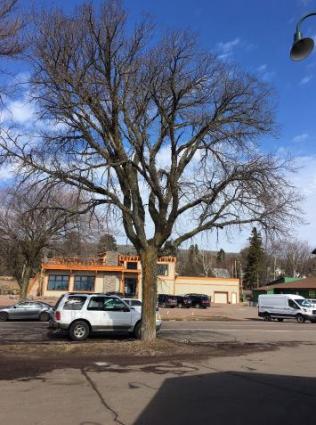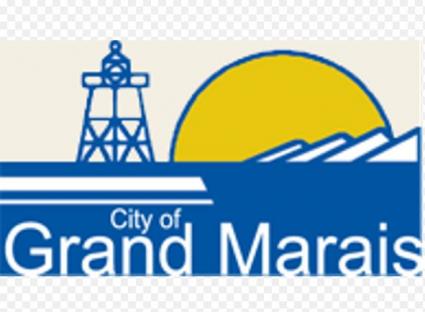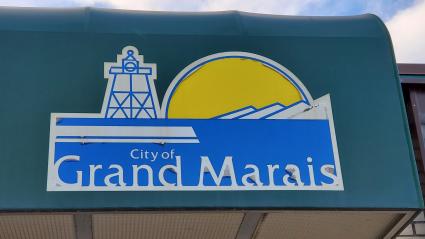Health of Grand Marais elm trees still being debated
At an August 8 meeting held by the Minnesota Department of Transportation, there was a large turnout of citizens who wanted MnDOT to reconsider its plans to remove the trees in the Highway 61 corridor during the upcoming road reconstruction project.
Of the 11 elm trees in the section of Highway 61 from the intersection by Voyageur Brewing to the intersection by Buck’s Hardware, nine are earmarked for removal.
The roadwork through that area of Grand Marais is scheduled for early 2020, however, according to MnDOT Project Engineer Andrew Deming, the elm trees will be taken down in November 2019. The earlier removal of the trees is due to restrictions on tree removal to protect the long-eared bat. Clearing cannot be done while bats are inhabiting the trees, so it must be done in the winter. Click to hear the interview with Project Engineer Andrew Deming.
There were many comments at that August 8 meeting about how important the trees are to the aesthetics of Grand Marais, as well as for cooling shade and environmental benefits. Hear a report on that meeting here.
There was also a great deal of frustration over the report put together by the MnDOT arborist which says the elm trees along the highway are in poor to moderate health. Click here to see that report.
After the idea of removing the trees from the road right of way was brought forward at a February 27, 2018 meeting, some citizens sought another opinion. Another arborist visited Grand Marais and inspected the trees.
This second report conflicts with the MnDOT report and says the trees are in fair to good condition, with many trees listed as very good condition. Click here to see the content of that evaluation.
However, the report has been called into question because the arborist who compiled it preferred to be unnamed.
WTIP Community Radio was able to obtain contact information for this arborist and after repeated requests for an interview, the arborist, who is a college professor specializing in urban and community forestry, replied to WTIP’s inquiries in an email. Click here to read that email response.
The professor prefaced his email response by saying that he conducted his assessment of the trees while visiting Grand Marais for another project on June 12.
He wrote: I did that at the request that my assessment be put in perspective as noted on my "report" that it was June and the trees had not fully leafed out at that time. I also requested that my assessment be kept out of any formal motions against MnDOT or the community's desire to upgrade the transportation infrastructure. I simply assessed the trees.
The arborist answered WTIP’s question about the procedure for assessing the trees by saying: The assessment system I used is called a "Limited Visual Inspection," which means I did no excavations near the root systems to detect any defects,
I did not conduct any mechanical investigations into loss of strength due to decay, and I took no samples to be submitted to the Plant Disease Clinic at the University to determine if any of the trees had an infectious disease.
The Limited Visual Inspection is the most common method of monitoring tree health and condition in urban forestry.
The professor’s evaluation looked at the condition of the tree canopy and root plate space. He lists one tree in fair to poor condition; two in fair condition; four trees in fair to good condition; one in good condition; and three in very good condition.
The MnDOT arborist report list describes four trees as in poor condition; four trees in fair to poor condition and three trees in fair condition. The arborist report says three trees could possibly remain, if they were protected during construction. However, at the August 8 meeting, Highway 61 Project Manager Michael Kalnbach said only two trees are slated to remain.
MnDOT and city officials state that the trees are not healthy enough to withstand construction activity that would impact the trees’ root system. Asked about that the second arborist replied by email: Health-wise, elms are very tolerant of most construction activities, but I do not know what MnDOT plans to do in terms of potential damage to the roots systems and stability of these elms.
Condition-wise, most trees that lose a lot of roots during construction activities go through a period of "defensive die back" where a few to many large branches die and pose a risk to vehicles, buildings, utility wires, and people near them if they are not attended to by an arborist who knows how to remove dead wood without causing more damage.
I do know that there are different technologies and practices that can be used to limit the amount of damage to root systems during construction, but again I don't know what type of damage is likely to be incurred by these trees.
I also know that weather plays a huge role in whether or not trees survive and root systems recover enough to rebuild the stability of those damaged trees. I have no idea what the weather will be like preceding the construction, during the construction and post-construction for several years.
The arborist added some information to be published in the scientific journal, Arboriculture and Urban Forestry:
In a recent research project that I completed on the impacts of construction activities and tree stability, we found that boulevard trees that had partial root loss due to sidewalk removal and improvements were 2.4 times more likely to fail (aka, fall over) during wind loading events (ranging from severe thunderstorms to straight-line winds). The trees were healthy, they survived the construction activities, but they were unstable and more likely to fail and subsequently cause damage. This research has been accepted for publication this autumn in a scientific journal (Arboriculture and Urban Forestry).
The professor said he could not, in his role, provide a formal assessment that could be done by a commercial company that does this work. Finally, he added: There are way too many factors that need to be thoroughly evaluated before any decisions are made to save, remove, save some of the trees, challenge MnDOT and/or the City.
WTIP reached out to Highway 61 Project Manager Michael Kalnbach, who has been involved with the Grand Marais project for several years. Asked if MnDOT would consider hiring a third-party arborist, Kalnbach said it depends on what is in the report. However, as of August 19, Kalnbach said he had not received a copy of that report.
Listen:
Program:
Tweet







